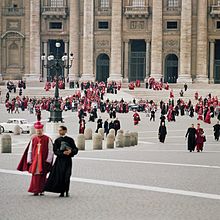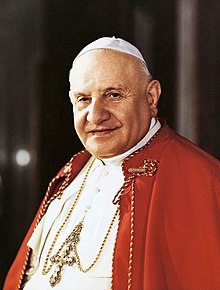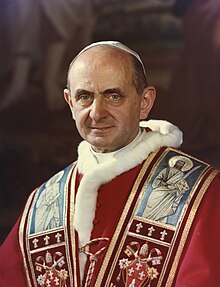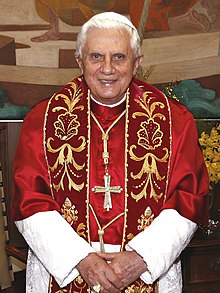Spirit of Vatican II: Difference between revisions
m Task 18 (cosmetic): eval 15 templates: del empty params (15×); hyphenate params (5×); del |url-status= (1×); cvt lang vals (2×); |
dopl. |
||
| Line 1: | Line 1: | ||
[[File:Second Vatican Council by Lothar Wolleh 006.jpg|thumb|Council fathers leaving St. Peter's Basilica]] |
|||
By the '''spirit of Vatican II''' is meant the teaching and intentions of the [[Second Vatican Council]] interpreted in a way that is not limited to a literal reading of its documents, or even interpreted in a way that contradicts the "letter" of the Council<ref>[http://home.comcast.net/~icuweb/c02206.htm James Hitchcock, The History of Vatican II, Lecture 6: The Effects of Council Part II]</ref><ref>[[Avery Dulles]], [http://www.americamagazine.org/content/article.cfm?article_id=2810 Vatican II: The Myth and the Reality]</ref> (cf. [[Paul the Apostle|Saint Paul's]] phrase, "the letter kills, but the Spirit gives life").<ref>{{bibleverse|2|Corinthians|3:6|NIV}}</ref> This has led to a great diversity of understanding of the phrase. |
By the '''spirit of Vatican II''' is meant the teaching and intentions of the [[Second Vatican Council]] interpreted in a way that is not limited to a literal reading of its documents, or even interpreted in a way that contradicts the "letter" of the Council<ref>[http://home.comcast.net/~icuweb/c02206.htm James Hitchcock, The History of Vatican II, Lecture 6: The Effects of Council Part II]</ref><ref>[[Avery Dulles]], [http://www.americamagazine.org/content/article.cfm?article_id=2810 Vatican II: The Myth and the Reality]</ref> (cf. [[Paul the Apostle|Saint Paul's]] phrase, "the letter kills, but the Spirit gives life").<ref>{{bibleverse|2|Corinthians|3:6|NIV}}</ref> This has led to a great diversity of understanding of the phrase. |
||
== 1962{{ndash}}1967 == |
== 1962{{ndash}}1967 == |
||
[[File:Ioannes XXIII, by De Agostini, 1958–1963.jpg|thumb|John XXIII]] |
|||
[[File:Paulus VI, by Fotografia Felici, 1969.jpg|thumb|Paul VI]] |
|||
According to [[peritus]] [[Yves Congar]], in an address to the council on 3 December 1962, [[Paul-Émile Léger|Cardinal Léger]] "wishes that the spirit of renewal be protected by a committee that will authoritatively protect the spirit of the council in the period between the two sessions".<ref>{{cite book |last=Congar |first=Yves |author-link=Yves Congar |title=My Journal of the Council |year=2012 |publisher=Liturgical Press |isbn=978-0814680292 |page=229 |others=translated by Mary John Ronayne, Mary Cecily Boulding, Denis Minns}}</ref> |
According to [[peritus]] [[Yves Congar]], in an address to the council on 3 December 1962, [[Paul-Émile Léger|Cardinal Léger]] "wishes that the spirit of renewal be protected by a committee that will authoritatively protect the spirit of the council in the period between the two sessions".<ref>{{cite book |last=Congar |first=Yves |author-link=Yves Congar |title=My Journal of the Council |year=2012 |publisher=Liturgical Press |isbn=978-0814680292 |page=229 |others=translated by Mary John Ronayne, Mary Cecily Boulding, Denis Minns}}</ref> |
||
| Line 9: | Line 12: | ||
== 1974-1982 == |
== 1974-1982 == |
||
[[File:Marcel Lefebvre 1981b.jpg|thumb|Abp. Marcel Lefebvre]] |
|||
[[Traditionalist Catholic]]s such as Archbishop [[Marcel Lefebvre]] distinguish between "Catholic Rome" and the actually existing [[Holy See|Rome]], as he declares in 1974 that, while he and his followers are faithful to "Catholic Rome", they refuse to follow "the Rome of neo-Modernist and neo-Protestant tendencies which were clearly evident in the Second Vatican Council and, after the Council, in all the reforms which issued from it".<ref>[http://www.sspx.org/SSPX_FAQs/appendix_I._declaration.htm 1974 Declaration of Archbishop Lefebvre] {{webarchive|url=https://web.archive.org/web/20061013232352/http://www.sspx.org/SSPX_FAQs/appendix_I._declaration.htm |date=2006-10-13 }}</ref> |
[[Traditionalist Catholic]]s such as Archbishop [[Marcel Lefebvre]] distinguish between "Catholic Rome" and the actually existing [[Holy See|Rome]], as he declares in 1974 that, while he and his followers are faithful to "Catholic Rome", they refuse to follow "the Rome of neo-Modernist and neo-Protestant tendencies which were clearly evident in the Second Vatican Council and, after the Council, in all the reforms which issued from it".<ref>[http://www.sspx.org/SSPX_FAQs/appendix_I._declaration.htm 1974 Declaration of Archbishop Lefebvre] {{webarchive|url=https://web.archive.org/web/20061013232352/http://www.sspx.org/SSPX_FAQs/appendix_I._declaration.htm |date=2006-10-13 }}</ref> |
||
| Line 14: | Line 18: | ||
== 1985-2013 == |
== 1985-2013 == |
||
[[File:Ioannes Paulus II in Germany (1980).jpg|thumb|John Paul II]] |
|||
[[File:BentoXVI-30-10052007.jpg|thumb|Benedict XVI]] |
|||
In the 1985 book ''The Ratzinger Report'', the then [[cardinalate|Cardinal]] [[Pope Benedict XVI|Joseph Ratzinger]] distinguishes the true spirit of the Council from false interpretations, blaming the disappointed hopes for renewal on "those who have gone far beyond both the letter and the spirit of Vatican II", and calling for a "return to the authentic texts of the original Vatican II".<ref>[https://www.nytimes.com/1985/12/22/books/at-the-pope-s-right-hand.html New York Times, 22 December 1985]</ref> |
In the 1985 book ''The Ratzinger Report'', the then [[cardinalate|Cardinal]] [[Pope Benedict XVI|Joseph Ratzinger]] distinguishes the true spirit of the Council from false interpretations, blaming the disappointed hopes for renewal on "those who have gone far beyond both the letter and the spirit of Vatican II", and calling for a "return to the authentic texts of the original Vatican II".<ref>[https://www.nytimes.com/1985/12/22/books/at-the-pope-s-right-hand.html New York Times, 22 December 1985]</ref> |
||
| Line 27: | Line 33: | ||
== Pope Francis == |
== Pope Francis == |
||
[[File:Franciscus (cropped).jpg|thumb|Francis]] |
|||
{{See also|Theology of Pope Francis#Background: Vatican II impulse for Francis' actions |
{{See also|Theology of Pope Francis#Background: Vatican II impulse for Francis' actions |
||
}} |
}} |
||
Revision as of 13:48, 14 January 2022

By the spirit of Vatican II is meant the teaching and intentions of the Second Vatican Council interpreted in a way that is not limited to a literal reading of its documents, or even interpreted in a way that contradicts the "letter" of the Council[1][2] (cf. Saint Paul's phrase, "the letter kills, but the Spirit gives life").[3] This has led to a great diversity of understanding of the phrase.
1962–1967


According to peritus Yves Congar, in an address to the council on 3 December 1962, Cardinal Léger "wishes that the spirit of renewal be protected by a committee that will authoritatively protect the spirit of the council in the period between the two sessions".[4]
In an address at Milan Cathedral on 7 June 1963, before the opening of the papal conclave of 1963, papabile Cardinal Montini said of Pope John XXIII who had died four days earlier, "If we still wanted to fix our gaze on the tomb, now sealed, we could speak about his legacy which that tomb cannot contain, about the spirit which he infused into our era and which death cannot suffocate".[5]
On 25 July 1967, Pope Paul VI said in a sermon to the Catholics of Istanbul at the Cathedral of the Holy Spirit:
The recent Vatican Council reminded us that this progress is based first of all on renewal of the Church and on conversion of heart. This means that you will contribute to this progress toward unity in the measure in which you enter into the spirit of the council. An effort is demanded from each of us to revise our customary ways of thinking and acting to bring them more in conformity with the Gospel and the demands of a true Christian Brotherhood.[6][7]
1974-1982

Traditionalist Catholics such as Archbishop Marcel Lefebvre distinguish between "Catholic Rome" and the actually existing Rome, as he declares in 1974 that, while he and his followers are faithful to "Catholic Rome", they refuse to follow "the Rome of neo-Modernist and neo-Protestant tendencies which were clearly evident in the Second Vatican Council and, after the Council, in all the reforms which issued from it".[8]
A priest of the Lefebvre-founded Society of St. Pius X similarly declares in 1982 that "Rome is now the headquarters, not only of the Catholic Church, but of the Modernist Mafia which has invaded and subjected it", and that "the multitudes of ex-Catholic shepherds and their sheep who have either defected or drifted into a new religion" might well be called "Roman Protestants".[9]
1985-2013


In the 1985 book The Ratzinger Report, the then Cardinal Joseph Ratzinger distinguishes the true spirit of the Council from false interpretations, blaming the disappointed hopes for renewal on "those who have gone far beyond both the letter and the spirit of Vatican II", and calling for a "return to the authentic texts of the original Vatican II".[10]
Pope John Paul II calls in 1994 for what he describes as the authentic spirit of the Council to be respected.[11]
In November 2003, Michael Novak describes what has been called the "spirit" of the Second Vatican Council as something that:
Sometimes soared far beyond the actual, hard-won documents and decisions of Vatican II.... It was as though the world (or at least the history of the Church) were now to be divided into only two periods, pre-Vatican II and post-Vatican II. Everything 'pre' was then pretty much dismissed, so far as its authority mattered. For the most extreme, to be a Catholic now meant to believe more or less anything one wished to believe, or at least in the sense in which one personally interpreted it. One could be a Catholic 'in spirit'. One could take Catholic to mean the 'culture' in which one was born, rather than to mean a creed making objective and rigorous demands. One could imagine Rome as a distant and irrelevant anachronism, embarrassment, even adversary. Rome as 'them'.[12]
In 2005, in a speech to the Roman Curia, Pope Benedict XVI says:
On the one hand, there is an interpretation that I would call "a hermeneutic of discontinuity and rupture"; it has frequently availed itself of the sympathies of the mass media, and also one trend of modern theology. On the other, there is the "hermeneutic of reform", of renewal in the continuity of the one subject-Church which the Lord has given to us. She is a subject which increases in time and develops, yet always remaining the same, the one subject of the journeying People of God.... The hermeneutic of discontinuity risks ending in a split between the pre-conciliar Church and the post-conciliar Church.... In a word: it would be necessary not to follow the texts of the Council but its spirit. In this way, obviously, a vast margin was left open for the question on how this spirit should subsequently be defined and room was consequently made for every whim.... The hermeneutic of discontinuity is countered by the hermeneutic of reform, as it was presented first by Pope John XXIII in his Speech inaugurating the Council on 11 October 1962 and later by Pope Paul VI in his Discourse for the Council's conclusion on 7 December 1965. ...It is precisely in this combination of continuity and discontinuity at different levels that the very nature of true reform consists. ...The continuity of principles proved not to have been abandoned.[13]
According to this view of Pope Benedict XVI, the correct view of the Council is that which interprets it "within the context of tradition, not as a rupture with tradition, and the false view is that which "only accepted as authentic the 'spirit' or progressive thrust of the documents and so rejected any elements of the older tradition found in the texts, which were regarded as compromises and so not binding".[14]
It has been suggested that the expression "spirit of Vatican II" and also the polarity "continuity" or "discontinuity" have both been found unhelpful in describing the "authentic communal shifts" that can be traced to the Council documents.[15]
Pope Francis
Pope Francis frequently speaks about a spirit of renewal that is in continuity with Vatican II, even as Pope John XXIII proposed in calling the Council to "throw open the windows of the church and let the fresh air of the spirit blow through.” Francis speaks of "reviving the spirit of the church,"[16]: 15, 17 even as Vatican II called for "audacious change in order to preserve, at a higher level and from a superior viewpoint, inherited values."[17] This is seen, for instance, in his call for mercy in the application of rigid moral principles,[18] arrived at through a spirit of collegiality called for by Vatican II.[19] The secular media report "a quiet intra-Church struggle between anti-Vatican II diehards and clerics who prefer John XXIII’s (and Francis’s) generosity of spirit."[20]
In the wake of the Synod of the Amazon called by Pope Francis in 2019, a suggestion put forth in The Tablet but criticized in the National Review, saw the Council's importance as an "event" that unleashed a spirit of renewal in a time when “our culture has become old, our churches and our religious houses are big and empty, the bureaucratic apparatus of the church grows, our rites and our dress are pompous”. [21]
References
- ^ James Hitchcock, The History of Vatican II, Lecture 6: The Effects of Council Part II
- ^ Avery Dulles, Vatican II: The Myth and the Reality
- ^ 2 Corinthians 3:6
- ^ Congar, Yves (2012). My Journal of the Council. translated by Mary John Ronayne, Mary Cecily Boulding, Denis Minns. Liturgical Press. p. 229. ISBN 978-0814680292.
- ^ Paul VI (1965). John XXIII: Pope Paul on his predecessor, and a documentation by the editors of Herder correspondence. Herder and Herder. p. 10.
- ^ Stransky, Thomas F. (1980). Doing the Truth in Charity: Statements of Popes Paul VI, John Paul II and the Secretariat for Christian Unity, 1964-1980. Paulist Press. p. 188. ISBN 0809123983.
- ^ Paul VI (25 July 1967). "Discours dans la cathédrale de l'Esprit Saint" (in French). www.vatican.va.
- ^ 1974 Declaration of Archbishop Lefebvre Archived 2006-10-13 at the Wayback Machine
- ^ Wrighton, Basil (August 1982). "Roman Protestants". The Angelus. Archived from the original on 2005-02-04.
- ^ New York Times, 22 December 1985
- ^ Apostolic Letter Tertio Millennio Adveniente, 36
- ^ Michael Novak (24 November 2003). "Introduction to The Open Church (Millennium Edition)". American Enterprise Institute. Archived from the original on 10 June 2011.
- ^ Benedict XVI (22 December 2005). "Christmas Address of His Holiness Benedict XVI to the Roman Curia".
- ^ D. Vincent Twomey, Pope Benedict XVI: The Conscience of Our Age (Ignatius Press 2007 ISBN 978-1-58617170-4), p. 33
- ^ Neil Ormerod, "Vatican II—Continuity or Discontinuity? Toward an Ontology of Meaning," Theological Studies 71 (2010): 610, 634-36. http://cdn.theologicalstudies.net/71/71.3/10.1177.004056391007100305.pdf
- ^ Fernández, Víctor M; Rodari, Paolo (2016). The Francis project: where he wants to take the church. ISBN 9780809149636. OCLC 934627692.
- ^ "Aggiornamento of Vatican II". vatican2voice.org. Retrieved 2020-02-05.
- ^ Yardley, Jim (2016-04-08). "Rather Than Rules, Pope's Document Gives License to Adapt". The New York Times. ISSN 0362-4331. Retrieved 2020-02-05.
- ^ Yardley, Jim (2016-04-08). "Rather Than Rules, Pope's Document Gives License to Adapt". The New York Times. ISSN 0362-4331. Retrieved 2020-02-05.
- ^ Hertzberg, Hendrik. "Hellbound After All?". The New Yorker. Retrieved 2020-02-05.
- ^ "Roma Locuta Est, Deal With It". National Review. October 28, 2019.
Further reading
- Sinke Guimarães, Atila (1997). In the Murky Waters of Vatican II. Metairie: MAETA. ISBN 1-889168-06-8.
- Amerio, Romano (1996). Iota Unum. Kansas City: Sarto House. ISBN 0-9639032-1-7.
